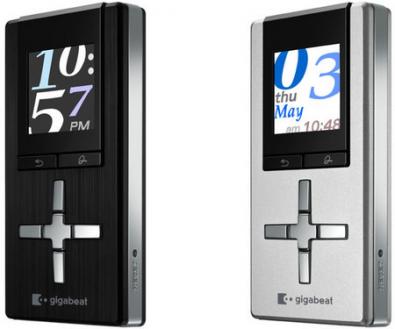
Toshiba has continually improved its gigabeat line of MP3 players since the release of its F series, but apparently last year’s S series was the peak. The latest in the line is the gigabeat U, a tiny flash-based player with Toshiba’s signature crossbar controls. Unfortunately, it doesn’t have its big brother’s sweet Windows Mobile interface, making it feel pretty much like the rest of the also-ran flash players. For some reason, Toshiba is playing up the line-in MP3 recording feature, but we’re more impressed with the fact that you get a decent-sounding 2GB music player for under 100 bucks.
If cheaper is better, the gigabeat U ranks up near the top. But other than the aggressive price, there’s not a whole to differentiate it from the rest of the pack. The player is very compact at 3 by 1.4 by 0.5 inches, and it has a squint-worthy 1.1-inch OLED screen. The four-way cross-shaped controls surround a center select button, and just beneath the screen are Back and contextual menu buttons marked with an arrow and an odd-looking squiggle, respectively.
On top there’s a power/hold switch, and on the bottom there’s a standard mini-USB 2.0 connector and an eighth-inch headphone/line-in jack. The player’s metallic textured finish isn’t nearly as attractive as the glossy finish on the larger S series, but it still manages to look cute.
The gigabeat U is exclusively a Media Transfer Protocol device, meaning it only syncs with Windows-based music management software like Windows Media Player and Yahoo Music Jukebox. Once again, Mac users and Audible audiobook fans are left out in the cold. It supports WMA, protected WMA (download and subscription), WAV, and MP3 files, and it’s one of the only players out there to support WMA Lossless, though that’s not particularly useful on a 2GB player given the size of lossless files.
Navigating the gigabeat’s simple but unpolished interface isn’t difficult, but it’s definitely no Windows Mobile; I wouldn’t mind the boring menus if my expectations hadn’t been set by previous gigabeat models. There’s a slight lag when browsing your music, but it’s not frustratingly slow.
You can see six lines of text plus the header line, but scrolling through long lists (at least, as long as you’re going to get with only 2GB of storage) isn’t painful. It’s not very precise either; when you scroll extensively, lists keep scrolling for a couple lines after you release the up or down button. One thing I like is that when you get to the end of a list, you’re automatically brought back to the top of the list.
Every time you make a selection, there’s an audible high-pitched sound that’s not annoying enough to make me stop using the player, but one does wonder why Toshiba didn’t catch this before release.
You can create playlists on the fly via the misnamed bookmarking feature, but you can’t actually make bookmarks (automatic go-to spots within a file). Musicians and language learners will be glad to know there’s an A-B repeat feature for looping parts of a track.
The system noise is limited to button presses and isn’t present during playback, thankfully. The gigabeat’s overall sound quality when paired with decent headphones (like my Shure SE 420’s) is very good across the entire audible frequency range, and I didn’t hear any significant distortion at top volume. The headphone output is powerful enough to hit moderate volumes on full-size cans from the likes of Sennheiser and Grado, and it has no problem with any of the in-ear headphones I tried.
The included earbuds suck, and I’m not impressed by any of the sound-enhancement settings (a 5-band EQ and a handful of presets), but those are par for the course. At least you get a very respectable 30 hours of audio playback time on a single charge.
The combo headphone/input jack is for lining in audio and recording in MP3 format — in real time (45 minute CD takes 45 minutes to record). Although you can’t monitor your recordings via headphones, there are left and right level monitors on the screen. I could hear the compression on recordings, but the quality is certainly passable. If you’ve got a powered mic, the gigabeat could make a good recorder in a pinch, but I’d prefer something that records uncompressed audio, or at least higher bit rate MP3s.
The gigabeat lacks a voice recorder, but it’s got an FM tuner that can pick up stations reasonably well, though fringe stations (like 88.3FM in Newark, New Jersey) aren’t particularly clear. You can also record from the radio, which I find more useful than line-in recording.
Photos look pretty lame (blocky and low-res) on the OLED screen, and the colors are oversaturated. Then again, do you really want to look at pictures on a 1.1 inch screen? I’ll pass. The only other extra is a countdown/sleep timer.
The gigabeat U clearly isn’t out to impress anyone, but it could make a decent stocking stuffer by the time the holidays roll around — if other players like the iPod nano and iRiver Clix haven’t dropped in price by then, that is. At this price, the Creative Zen V Plus is the gigabeat’s main competitor; I prefer the Zen slightly for its better radio reception, voice recorder, video support, and bigger screen.